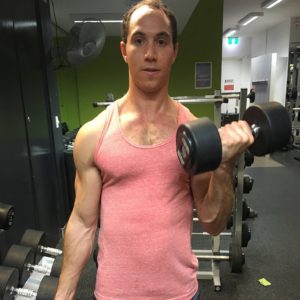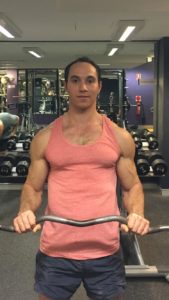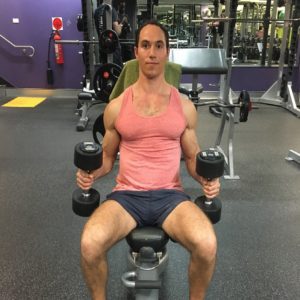Biceps! Everyone’s favourite muscle to train whether we’d like to admit it or not. So what is the best way to fill out those loose t-shirt sleeves? Read on.
The ‘bi’ in biceps in anatomical terms means ‘two’, however the biceps are actually made up of 3 muscles with one of those having 2 separate ‘heads’ or muscle bellies, which explains the above.
Quick anatomy lesson: The biceps includes the biceps brachii – which has a long and short head. On the human body these are the muscles responsible for the bicep ‘peak’, as they are superficial muscles. The short head flexes the elbow joint, a standard bicep curl, due to its attachment point. The long head however attaches up at the shoulder so while it does elbow flexion it also helps to flex the shoulder or lift your arm straight up in front. These two muscles get preferentially activated when our elbow is supinated or when the palm is facing up.
So now we know what movements the bicep muscles do, it would make sense to complete standard biceps curls with the palm facing up to maximise growth potential. Now there are obviously numerous ways to do a standard biceps curl with the palms up. Below is a standing unilateral (alternate one arm then the other) variation with dumbbells, but this could also be done as bilateral (both at the same time), seated, seated with bench on incline, preacher curls, concentration curls, free weights- bar or dumbbells, cables etc.
To work the long head, again there are various options. Below is a standing unilateral dumbbell variation, however like the above this could be varied with cables, bilateral, altering position with an incline bench etc. Combinations of the two can be done with the shoulder flexed to 90 degrees and then flexing the elbow to maximally shorten both heads.
The second muscle is the brachialis, this sits underneath the biceps brachii and preferentially gets activated when the elbow is pronated, or palms down. This muscle gives the biceps its width. Brachiallis is also responsible for elbow flexion, so to maximise its potential we want to do a biceps curl with the palms facing down. Below is a standing pronated bicep curl using the Ezy bar. Again there are various ways to work this muscle using a standard straight bar, dumbbells and cables or changing the angle.
The last is the brachioradiallis, this muscle sits a lot lower than the others and is responsible for elbow flexion, pronation and supination. On the body, brachioradialis is at the top of your forearm and is a superficial muscle. This muscle gets preferentially activated when the palm is in neutral or when the palm is facing towards your thigh. Below is a bilateral seated hammer curl, however like the above this can be varied in similar ways.
With all that said no muscle ever gets activated in isolation so all the above variations will still activate each bicep muscle. It should be noted that while we do want to do the above accessory movements to attempt to ‘isolate’ the biceps, many back exercises will also work biceps and allow us to lift much heavier loads – think row and pull-down movements where the elbow is flexing, so the above variations in hand position can be applied to back exercises too. With that said, to truly maximise growth, resistance training principles such as progressive overload, specificity and nutrition must be adhered to, but they are subjects for another day.









